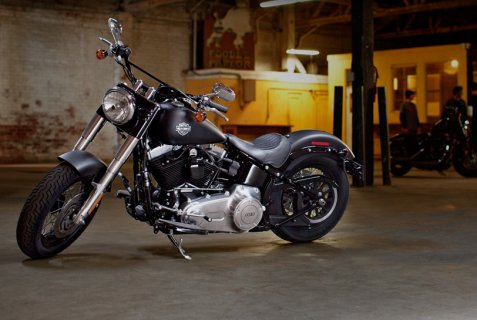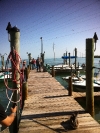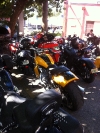Harley-Davidson Softail Slim Review
Posted by Joe Gustafson (03/06/2012 @ 12:00 pm)
Many have claimed that rock is dead, and if recent trends are anything to go by, they may be right. As the Black Keys’ screed against Nickelback last January showed, rock is struggling to reconnect with a generation that has turned to auto-tuned, plastic pop stars for entertainment instead of the thrum of electric guitars. But the main reason why people have turned away from rock has gone unsaid. Rock was always about rebellion, but lost people when the image of rebellion overtook the message. Like rock, motorcycles are a symbol of rebellion in culture gone soft. Also, like rock, they are struggling to reinvent themselves for a new generation after marketing rebellion instead of living it. However, as Harley-Davidson’s Softail Slim shows, rebellion is not dead in the motorcycle marketplace. And if this bike is anything to go by for both rock and motorcycles, the way to reconnect with younger kids may be going back to what made you so popular in the first place.
The Softail Slim is one of two new Dark Custom motorcycles that harkens back to the days of the choppers and bobbers from the 1950s. In the ‘50s, choppers weren’t just something you could buy; they were built with bare hands and bad attitudes as a serious style statement. To bring the Slim in line with this attitude, the bike is finished with a few time-appropriate design cues. But it’s not enough to just make the bike look old and then market it as something badass; the product should actually act out the marketing message. What Harley has done to the Slim to capture that old chopper mindset is to follow up its vintage look with a really raw riding experience.
This first step in bringing the bike in line with its historical inspirations is to get the look right. First, the overall stance is slimmed down to give the bike a more custom look. The fenders are bobbed, turn signals and accessories are slimmed down or removed, a thin solo seat is placed on the bike, and skinnier tires with thick sidewalls are added. Then, a few period correct cues are put on, like the Hollywood handlebars on the bike. Characterized by the crossbeam on the top, and the gentle sweep to bring the bars closer to your hands, the Hollywood bars were originally a Harley-Davidson accessory back in the ‘50s that have been taken out of retirement to give this bike a more vintage feel.
However, like the lead guitar in a band, the center of attention on a Harley has always been the engine. In the Slim, the motor is a 103 cubic inch V-Twin that has had an extra dose of attitude added with a healthy coat of black paint. To highlight the vintage feel, a round air cleaner has been added. Internally, nothing is changed over other Softail models. What this means is that you get the same 79hp and 90lb feet of torque that is on other Softails, such as the Blackline we reviewed last year. But more importantly, this is where that vintage feel starts to shine through. The motor responds to inputs nicely, but along the way it vibrates, shimmies and shakes. It feels natural where other motors feel too refined and clinical. It’s more time machine than engine in that it really brings you back to how older bikes feel.
Read the rest of this entry »
Harley-Davidson: The Forgotten Art of the Road Trip
Posted by Joe Gustafson (03/04/2012 @ 12:00 pm)
In today’s market, speed rules the conversation. Superbikes, supercars, super(blank) are the center of attention. All marketing materials talk about is going faster and harder. Horsepower, lap times, and what minute difference is going to give one bike an edge is seemingly all we talk about with motorcycles, and what the public sees of us. But beyond the power, speed and fury that few people will use on the street, there is a whole type of riding that goes unnoticed: the road trip.
There used to be a valued segment of the marketplace for “grand tourers.” For cars, these were old Jaguars XK’s and graceful Aston Martins; machines that were built to effortlessly travel long distances with power and grace. As such, they were tuned to deliver a ride that would not rattle every bone in your body to dust. For motorcycles, it has always been the cruiser: Big, bold machines with slow turning engines that produce more torque than power. Many manufactures make bikes built for this segment, but only one has built their reputation on cruisers: Harley-Davidson. On our recent trip to Miami with Harley-Davidson, I discovered the experience of a road trip on a trip from Miami to Key West, and back, in one day.
The U.S. is built for road trips. Our roads are long and flat. Our country is big and wide. Culturally, we have always felt a need to push towards the frontier, and the road trip satisfies that need. It must then be easier to ride long distances than attacking a road course with Red Bull-aided fury since you really are riding in a straight line. But that’s not the case. The experience of a cruise is less technical precision than it is adapting to the little things that get in your way. This is where the difficulty lies.
Take the road itself. Not much attention is paid to it in a car because you don’t feel the differences in the pavement unless you’re in a sports car. On a bike, you feel the difference between where the road has been patched, the seams in the road, gravel, and how it may dip or rise in certain areas, and this all effects how the bike handles. The relationship is much more intense because it changes the way the bike moves.
Read the rest of this entry »
Harley-Davidson: The Art of Custom
Posted by Joe Gustafson (03/02/2012 @ 10:05 am)
Look, sound and feel. These are the defining traits of the Harley-Davidson brand as told by Willie G. Davidson. The look is characterized by simple designs that highlight the mechanics of the bike. The sound is the familiar loping idle of their V-Twin engines. And the feel is contained in the details such as finishes and riding characteristics that make a Harley feel substantial and sure-footed. More importantly, these traits are used as launching pads for owners to put their own spin on the bike. It is in this culture of customization that the bike becomes more than another mass-produced good, but a part of the owner’s life.
Customization has been ingrained in Harley owners since the very start. From small touches on the very earliest bikes – such as headlights – to fully customized examples seen today, a bike’s design process does not stop at the factory, but begins in the hands of the owner. This needing of expression from owners has driven Harley to offer more products that reflect their tastes and preferences. One way to do this is to offer bikes that display classic design cues from the past. Motorcycles such as the ‘72 and the Softail Slim do just that, reinventing them for a generation that wants to feel connected to a history that they were not a part of. “They want that feeling of something both mechanical and natural,” as Willie G. Davidson describes it. These products are machines that grow with you instead of being disposed of within a year or when the contract expires.
But offering more bikes is just the first step in a customer’s relationship with the brand. After the bike is bought, owners have access to an extensive list of parts and accessories (P&A) to customize their bike. A variety of finishes, parts and equipment are available. The part offerings include things from grips to exhausts and everything in between. Also, dealers have the ability to work with you on a personal level in order to get parts that fit the exact look you're going for. Of course, there are enough chrome items to fill the Bible, but there are also a variety of parts that you’d be surprised to find.
(more…)











































